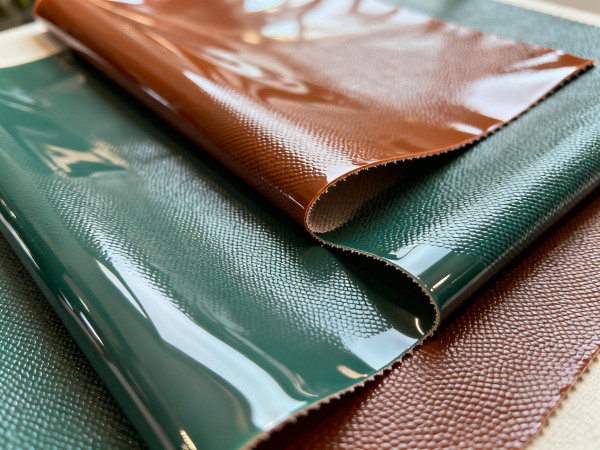Fire retardant PVC fabric is a versatile material widely used in industries that require enhanced safety measures. This fabric combines the durability and flexibility of standard PVC with the added feature of fire resistance. The primary difference between standard PVC and fire retardant PVC lies in its treatment: the latter undergoes a chemical process that ensures the material resists ignition and limits the spread of flames, making it safer for high-risk environments.
Unlike traditional PVC fabric, which is highly susceptible to catching fire, fire retardant PVC fabric meets stringent safety standards that help protect both property and people. It is commonly used in tents, industrial covers, upholstery, and other applications where fire safety is critical.

Why Choose Fire Retardant PVC Fabric?
The choice to use fire retardant PVC fabric is often driven by safety and compliance needs.
Here are several compelling reasons why this fabric is chosen over others:
Enhanced Safety: Fire retardant PVC fabric reduces the risk of fire hazards by slowing down the ignition process and preventing flames from spreading. This makes it ideal for high-risk environments such as construction sites, chemical plants, and public events.
Compliance with Regulations: Many industries are required by law to use fire-resistant materials to ensure the safety of workers and the general public. Fire retardant PVC fabric meets the necessary fire safety standards, ensuring compliance with local and international regulations.
Versatility: This fabric is suitable for a wide range of applications, from outdoor tents to industrial coverings and even vehicle upholstery. Its fire-resistant properties make it a reliable choice for various high-risk industries.
Key Applications of Fire Retardant PVC Fabric
Fire retardant PVC fabric’s ability to withstand heat and flames makes it indispensable in several industries:
Tents and Event Covers: Used for outdoor events, exhibitions, and festivals, fire retardant PVC fabric ensures that large structures remain safe for attendees and staff, even in the event of a fire.
Industrial Covers and Tarpaulins: Often used in warehouses, factories, and construction sites, fire retardant PVC fabric protects valuable equipment and materials from fire hazards, while also providing shelter from the elements.
Upholstery and Seating: In transportation industries such as buses, trains, and airplanes, fire retardant PVC fabric is used for seat coverings and upholstery to enhance passenger safety.
Protective Clothing and Gear: Certain protective garments and safety covers are made from fire retardant PVC fabric to safeguard workers in hazardous environments like oil rigs and chemical processing plants.
How Fire Retardant PVC Fabric Works
The fire resistance of PVC fabric is achieved through the incorporation of fire-retardant chemicals during the manufacturing process. These chemicals either slow down the ignition process or create a protective barrier that prevents flames from spreading.
The primary mechanism by which fire retardant PVC fabric works is through char formation. When exposed to heat or flames, the fabric forms a protective carbonized layer on its surface, which acts as a barrier that limits the flow of oxygen to the burning area. This prevents the fire from spreading further and helps contain the damage. The added chemicals also reduce the material's flammability, making it much harder for the fabric to ignite in the first place.
Durability and Maintenance of Fire Retardant PVC Fabric
Fire retardant PVC fabric is known for its impressive durability. Unlike other materials that may lose their fire resistance over time, fire retardant PVC retains its protective properties for a long period, even with frequent exposure to the elements.
To maintain its fire resistance and extend its lifespan, proper care is required:
Regular Cleaning: Keeping the fabric clean from dust, dirt, and other debris helps maintain its protective features. Use a mild detergent and warm water for cleaning.
Avoiding Harsh Chemicals: Avoid using harsh chemicals or solvents, as they can degrade the fire-retardant properties of the material.
Proper Storage: When not in use, store fire retardant PVC fabric in a dry, cool environment to avoid unnecessary wear and tear.
How to Check Fire Retardant PVC Fabric’s Quality
Not all fire retardant PVC fabrics are created equal. When purchasing this material, it is essential to ensure that the fabric meets the required safety standards.
Here are a few tips to check the fabric’s quality:
Look for Certifications: Fire retardant PVC fabric should come with certifications that indicate it meets the fire resistance standards set by governing bodies like the NFPA (National Fire Protection Association) or ASTM (American Society for Testing and Materials).
Test for Durability: High-quality fire retardant PVC fabric should be resistant to abrasion, UV degradation, and chemical exposure. Perform a simple wear test to assess its durability.
Confirm the Fire Rating: Verify the fire rating of the fabric by checking the manufacturer’s specifications. Higher ratings indicate better fire resistance.
Choosing the Right Fire Retardant PVC Fabric for Your Needs
Selecting the right fire retardant PVC fabric depends on the specific requirements of your application. Consider the following factors before making a purchase:
Thickness: Thicker fabrics provide better protection but may be less flexible. Consider the weight and flexibility needed for your application.
Fire Rating: Different fire retardant PVC fabrics are rated for different levels of fire exposure. Ensure the fabric you choose meets the necessary fire safety rating for your environment.
Weather Resistance: For outdoor applications, choose fabric that also offers UV resistance and waterproofing to ensure durability under all weather conditions.
Fire retardant PVC fabric is a vital material for ensuring safety in high-risk environments. With its fire-resistant properties, durability, and versatility, it is an essential choice for industries like construction, transportation, and event planning. By understanding its features and benefits, you can make an informed decision about whether this fabric is the right solution for your needs.






























